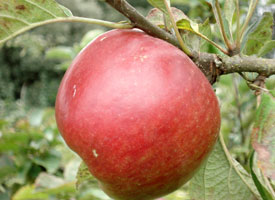History of the First and Last apple
The First and Last apple was first described in 1860. Hogg (1851) wrote that it is “much grown in the northern part of the county about Horsham and sent to Brighton market.”
It is currently cultivated as part of Brighton Permaculture Trust’s National Collection in Stanmer Park, Brighton. You can see a First and Last apple tree (planted 2009) in Home Farm Orchard, Stanmer Park ( map).
Description of fruit
The shape of the First and Last apple is rectangular to conic with slight ribbing, with a lemon yellow skin, flushed red and streaked and blotched darker red with some russet, slightly ribbed at eye.The flesh is a crisp, fine, greenish white with a slightly sweet flavour.
Season of use
The fruit can be picked in mid October and stored until April. At West Dean Gardens, it is said to store for two years.
Flowering and pollination
Flowering day: F14
How to identify a First and Last apple
Apples can be identified by sending them to the National Fruit Collection at Brogdale or by bringing a sample to Apple Day Brighton, where an expert pomologist will be on hand to identify apples. From each tree, bring three or more ripe fruits and a shoot with representative leaves.
Where to buy a First and Last apple tree
Please contact us for details of our supplier for Sussex apple varieties.
